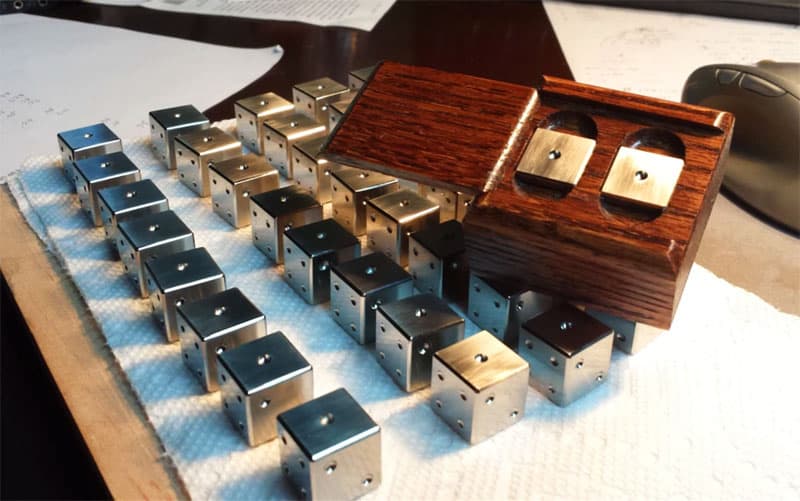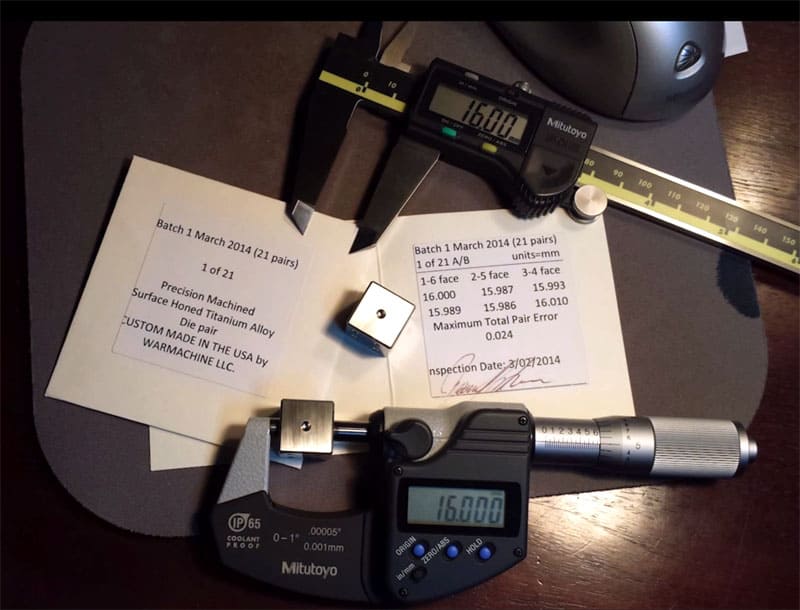I greatly appreciate hearing about the unique ways our customers are utilizing G-Wizard. It's especially fascinating when they take the time to chronicle an extraordinary project. Presenting, by James Dressman, are these meticulously machined Titanium Dice. Despite the significant amount of effort put into creating these, the final product is a set of dice showcasing exquisite craftsmanship.

The Titanium Dice and their presentation box...

You gotta love the idea of including an inspection sheet: that's a true machinist's touch!
James has included a series of videos so you can see how he did it. I will embed them below, but you should subscribe to his channel to see what he's up to over time. The Ti Dice won't be his last project I'm sure. As I was watching the videos, I jotted down some of the good practices and tips I saw:
- Use of Stops on Bandsaw and Milling Vise, Endmill as vise stop: Work stops are great time savers. I make sure I have one in place for virtually every job. If nothing else, it saves me if I pull a part and discover it needs to go right back where it came from.
- 1 insert in a Face Mill makes a Fly Cutter for better Surface Finish: This is a trick available to anyone with a facemill. Just pull all but one insert and you've converted your face mill into a fly cutter. It won't remove material as quickly, but it'll leave a nicer surface finish.
- Use a face mill just a little bigger than the work for best results. Small parts need smaller face mills. This is more in the commentary as James has a fairly large face mill. He notes that a smaller one could get the job done a little faster and keep the rpms up for perhaps a better surface finish.
- Rough cutting on the bandsaw saves machining time and money. A lot of beginning machinists want to cut everything out with an endmill. That does automate more of the process, but the bandsaw can do the work faster and more efficiently. Waterjets and laser cutters are the next step after a bandsaw. With a decent waterjet, you might only need a finish pass for the part outline and no roughing at all. In this application, what's also important is that Titanium stock is expensive, so use it sparingly. Turning a bunch of it into chips by relying too much on the endmill to cut out the parts is going to be more expensive.
- Polishing wheel work and Surface plate honing: Some nice shots of finishing these dice. Everybody loves "bling" on machined parts, but few take the time to really document how to achieve it.
Here are the videos:
Getting started with the process required some experimentation...
Starting to be a little more mass produced...
Finish work with a buffer and some surface plate honing...
Making the wooden presentation cases on the mill...
This was a nice little run of dice. I always learn more from producing a batch than from one-offs. With a batch you've got a chance to refine the operations as you learn. With a one-off it's mostly about adapting later steps to what goes on in the earlier steps. James says in the videos that these dice were an awful lot of work and he wasn't sure he'd be doing too many more. I'm sure there's a number of ways he could make his process more efficient. Off the top of my head I'd be looking to get his local waterjet house to cut the blanks, looking at fixtures, and using strictly the facemill rather than the combination of rougher and facemill to finish the faces. A fourth axis would allow 3 sides of the dice to be finished at a time too. Lastly, a big vibratory polisher might save a fair amount of that finish polishing. I'm thinking that since these dice are small and fairly time consuming, a vise pallet fixture might work well. In other words, build a fixture plate that holds a grid of dice and fits into the vise jaws.
What ideas do you have for James to speed up his production?
Be sure to check out the YouTube Channel for more information.
Be the first to know about updates at CNC Cookbook
Join our newsletter to get updates on what's next at CNC Cookbook.